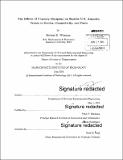The effects of capacity discipline on smaller U.S. airports : trends in service, connectivity, and fares
Author(s)
Wittman, Michael D. (Michael David)
DownloadFull printable version (15.99Mb)
Other Contributors
Massachusetts Institute of Technology. Department of Civil and Environmental Engineering.
Advisor
Peter P. Belobaba.
Terms of use
Metadata
Show full item recordAbstract
After decades of growth in domestic flights, seats, and available seat-miles, airlines reduced capacity at airports across the United States from 2007-2012 in response to a global economic downturn and high and volatile fuel prices. Despite an economic recovery and more stable fuel prices, airlines continued to keep domestic capacity low relative to historical levels. This strategy, which has been referred to as "capacity discipline," has had widespread implications for the entire U.S. air transportation network. This thesis examines the effects of capacity discipline on service availability, network connectivity, and fares in the U.S. air transportation network, particularly at smaller airports. We find that airlines cut flights at large airports by 8.8% from 2007-2012, as compared to a 21.7% reduction in flights at smaller airports over the same time period. As a result, some smaller airports may be particularly vulnerable to losing all network carrier service. Capacity discipline also changed the mix of carriers that served smaller airports. In many cases, network carriers providing service from smaller airports to connecting hubs were replaced by ultralow- cost carriers providing less-frequent service. We create an airport connectivity index to explore these effects of capacity discipline on airports' connections to the global air transportation network. The index model suggests that smaller airports lost more connectivity than larger airports in multi-airport regions. Finally, we examine changes in airfares as a result of capacity discipline. We find that medium-sized airports saw the largest increases in airfares-11.9% on average-from 2007-2012. Additionally, while the presence of low-cost carriers is still associated with in a decrease in the average one-way fare at an airport, the effects of some LCCs such as Southwest Airlines have diminished over time. Capacity discipline may be an unstable equilibrium when viewed in the game-theoretic context of the "prisoner's dilemma." With lower levels of connectivity and increasing fares, smaller airports in multi-airport regions will need to employ creative strategies to prevent passengers from leaking to primary hubs. Whether these airports can recover from service consolidation will also depend on how long this capacity discipline equilibrium remains in effect among U.S. airlines.
Description
Thesis: S.M. in Transportation, Massachusetts Institute of Technology, Department of Civil and Environmental Engineering, 2014. Cataloged from PDF version of thesis. Includes bibliographical references (pages 163-168).
Date issued
2014Department
Massachusetts Institute of Technology. Department of Civil and Environmental EngineeringPublisher
Massachusetts Institute of Technology
Keywords
Civil and Environmental Engineering.